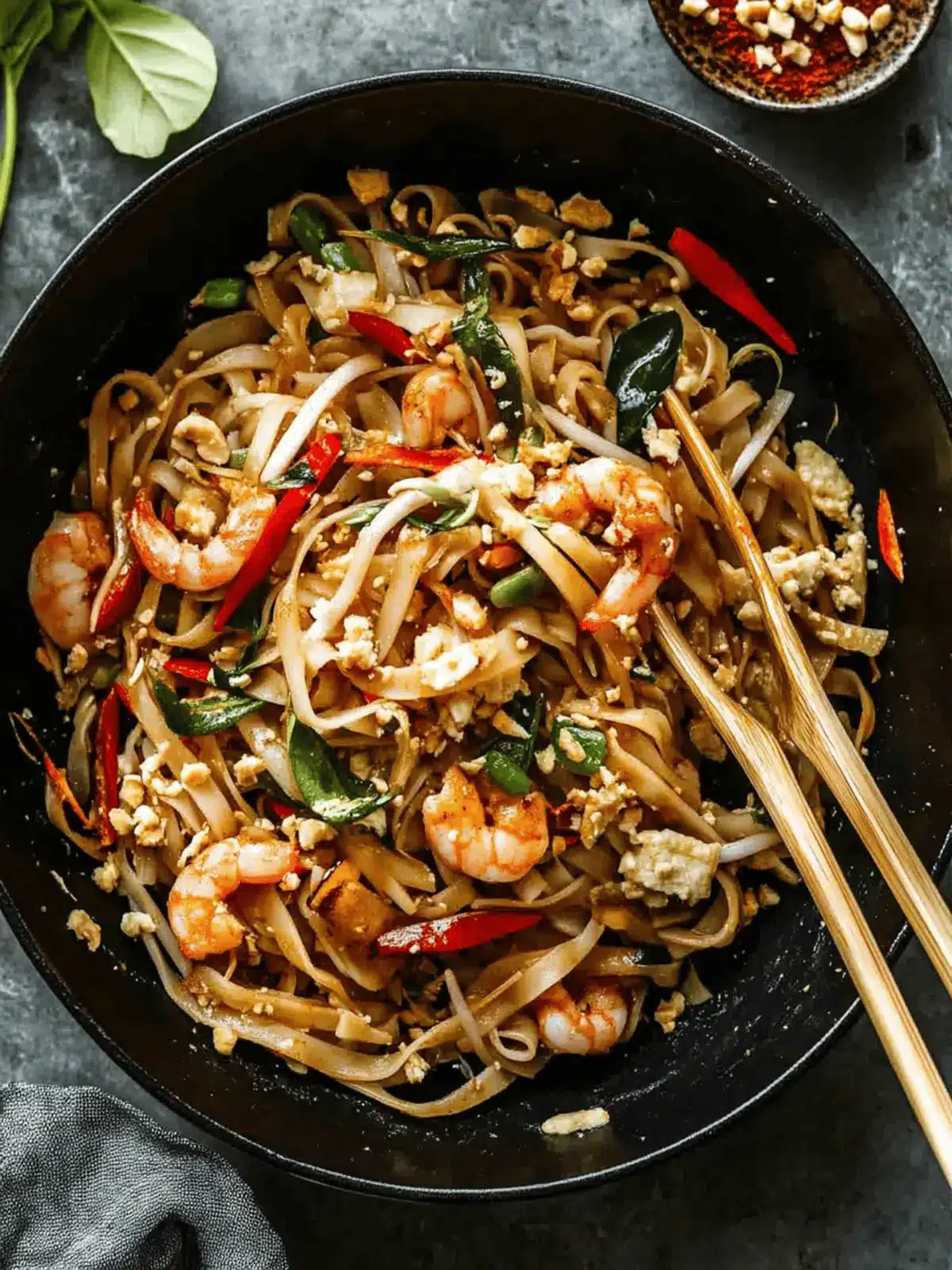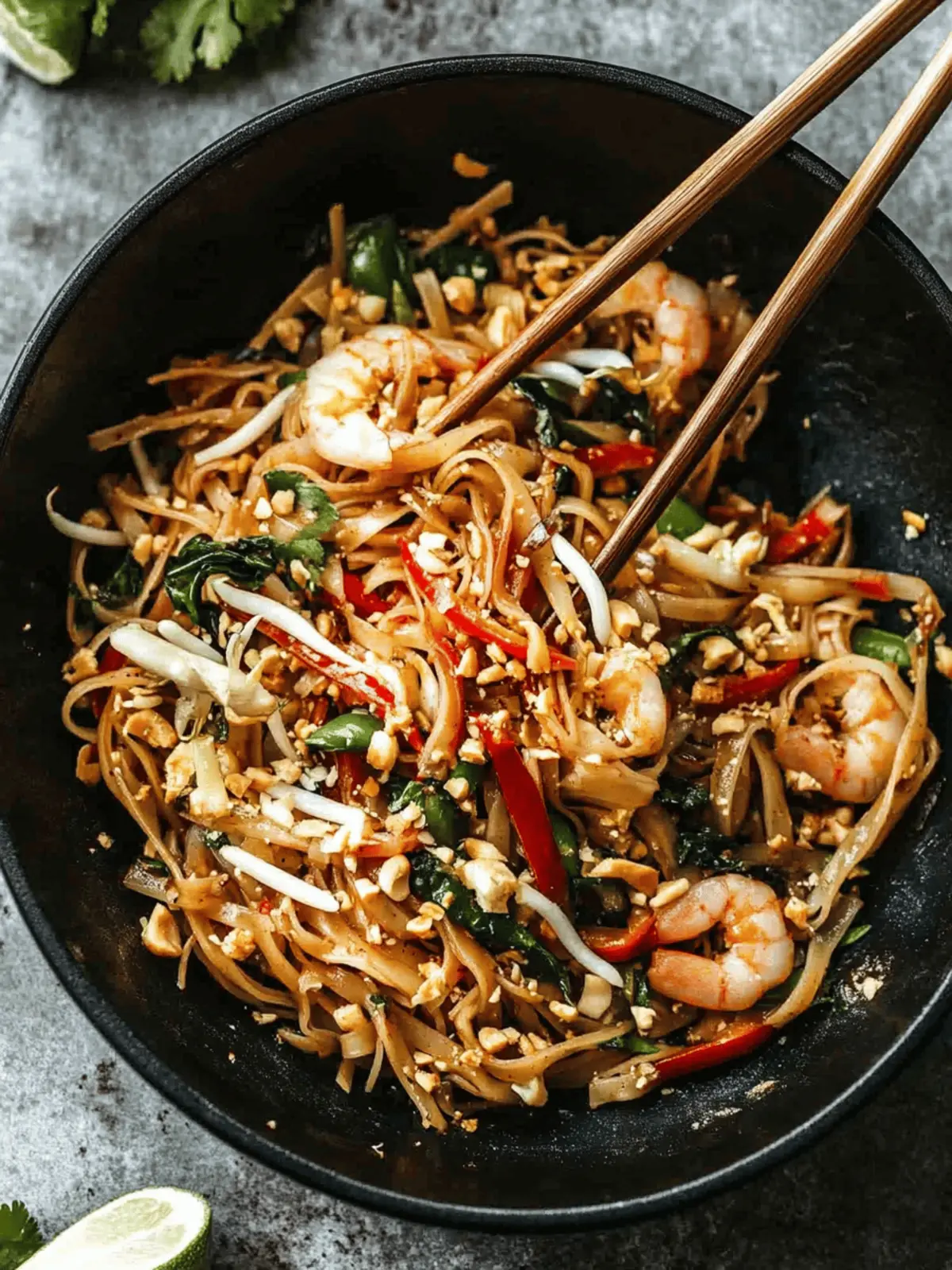The moment I took my first bite of Pad Thai, I couldn’t believe how such a vibrant dish could be so easy to make at home. This classic Thai street food is a perfect harmony of flavors and textures—crunchy peanuts, fresh bean sprouts, and the satisfying chew of rice noodles all come together in a heavenly dance. Whether you’re winding down after a hectic day or prepping for a cozy gathering with friends, this recipe transforms ordinary ingredients into a flavorful experience that feels both special and comforting.
I remember the first time I attempted to recreate this dish; it felt like a culinary adventure right in my kitchen! With just a few simple steps, you can impress your family and friends while indulging in the delightful taste of Pad Thai that rivals any takeout. So grab your wok, and let’s discover how to whip up this seemingly exotic meal in the comfort of your home. You won’t be disappointed!
Why is Pad Thai a Must-Try?
Unforgettable Flavors: This Pad Thai bursts with savory and sweet notes that will tantalize your taste buds. Each bite is a celebration of bold flavors!
Quick and Easy: Ready in just 30 minutes, it’s perfect for busy weeknights while still feeling like a restaurant-quality meal.
Customizable Ingredients: Whether you choose shrimp, chicken, or tofu, you can easily make this dish your own.
Crowd-Pleasing Delight: Impress your family or dinner guests—everyone loves this beloved classic!
Fresh Ingredients: With nutritious veggies and protein, you’ll feel good about serving this dish. Get ready to elevate your weeknight dinners!
Delicious Pad Thai Ingredients
For the Noodles
• Flat rice noodles – These soft noodles soak up the Pad Thai flavors beautifully, making them a must-have for this dish.
For the Protein
• Shrimp, chicken, or tofu – Choose your favorite protein to make this Pad Thai uniquely yours; shrimp adds a delightful sweetness!
For the Vegetables
• Garlic – Freshly minced garlic infuses the dish with aromatic goodness.
• Fresh bean sprouts – They provide a crunchy texture and a burst of freshness.
• Red bell pepper – Adds a sweet flavor and vibrant color to your plate.
• Green onions – Sprinkle them on top for a pop of freshness.
• Fresh cilantro – A must for that authentic Pad Thai taste.
For the Sauce
• Fish sauce – This adds a savory umami depth; don’t skip it!
• Low-sodium soy sauce – Balances the flavors without overwhelming the dish.
• Light brown sugar – Enhances the sweetness; feel free to adjust for your taste!
• Rice vinegar or tamarind paste – Use rice vinegar for tang; tamarind paste gives an extra zing.
• Sriracha hot sauce – Adjust to your spice level; it adds a lovely kick.
• Creamy peanut butter (optional) – For a richer sauce and heightened peanut flavor!
For Garnishing
• Dry roasted peanuts – Crunchy and nutty, they add the perfect topping to your Pad Thai.
• Limes – A squeeze of lime brightens the dish and ties the flavors together beautifully.
How to Make Pad Thai
-
Cook the noodles: Boil the flat rice noodles according to package instructions until tender. Once ready, rinse them under cold water to stop the cooking process and set aside.
-
Prepare the sauce: In a bowl, combine the fish sauce, soy sauce, brown sugar, rice vinegar or tamarind paste, and Sriracha hot sauce. Whisk until well mixed, then set it aside for later use.
-
Heat the wok: In a wok or large saucepan, heat 1½ tablespoons of oil over medium-high heat. Add your choice of shrimp, chicken, or tofu, along with minced garlic and sliced bell pepper. Cook shrimp for about 1-2 minutes per side, or until they turn pink. If using chicken, cook until just cooked through, which takes about 3-4 minutes, flipping only once.
-
Scramble the eggs: Push the protein and vegetables to the side of the pan. Add a bit more oil (if needed) and pour in the beaten eggs. Scramble them gently, breaking them into small pieces as they cook—this should take just a couple of minutes!
-
Combine ingredients: Add the cooked noodles, sauce, bean sprouts, and most of the peanuts to the wok. Toss everything together until well combined, letting the noodles absorb the delicious flavors.
-
Garnish and serve: Top your Pad Thai with chopped green onions, extra peanuts, fresh cilantro, and lime wedges. Serve immediately while it’s still hot and fragrant!
-
Store leftovers: If you have any leftovers, store them in an airtight container in the fridge and enjoy within 2-3 days.
Optional: Serve with extra lime wedges for a zesty kick!
Exact quantities are listed in the recipe card below.
Make Ahead Options
Preparing Pad Thai ahead of time can save precious minutes during busy weeknights! You can cook the flat rice noodles and store them in the refrigerator for up to 3 days; just be sure to toss them with a little oil to prevent sticking. You can also prepare the sauce (fish sauce, soy sauce, brown sugar, rice vinegar or tamarind paste, and Sriracha) in advance and refrigerate it for up to 5 days—taste it before using, as flavors may deepen. When it’s time to cook, simply heat a wok, add your protein and vegetables, scramble the eggs, and then toss in the prepped noodles and sauce. This way, you’ll enjoy the same delicious Pad Thai with minimal effort when you’re ready to eat!
How to Store and Freeze Pad Thai
Fridge: Store leftover Pad Thai in an airtight container for up to 2-3 days. Make sure it has cooled down before refrigerating to maintain freshness.
Freezer: For longer storage, freeze Pad Thai in a freezer-safe container. It can last up to 2 months, but be mindful that the texture may change slightly upon reheating.
Reheating: When ready to enjoy, thaw in the fridge overnight. Reheat it gently in a pan over medium heat with a splash of water or broth to prevent drying out.
Airtight Packaging: To keep flavors locked in, ensure your storage container is tightly sealed. This helps maintain the delightful taste of your Pad Thai!
What to Serve with Pad Thai?
Savor a complete dining experience by complementing your Pad Thai with these tantalizing sides and beverages.
-
Crispy Spring Rolls: These delightful bites add a crunchy texture and a light, fresh flavor that pairs beautifully with Pad Thai.
-
Thai Cucumber Salad: A refreshing blend of cucumbers, herbs, and a tangy dressing balances the richness of the dish and enhances the meal.
-
Steamed Dumplings: Serve them alongside for a flavorful and hearty twist. Their savory filling adds extra satisfaction and complements the main dish.
-
Mango Sticky Rice: For dessert, this sweet treat offers a beautifully contrasting flavor and texture, making it a perfect ending to your meal.
-
Thai Iced Tea: This creamy and sweet beverage is a wonderful companion to your Pad Thai, helping to cut through the spices with its smooth richness.
-
Peanut Satay Skewers: Add a protein-packed side that brings an extra nutty flavor, echoing the peanuts in the Pad Thai and enhancing its savory profile.
Enjoy the delightful variety and make your meal unforgettable!
Expert Tips for Pad Thai
• Noodle Perfection: Ensure your flat rice noodles are cooked al dente. Overcooking can lead to mushy noodles that don’t hold their shape in the dish.
• Flavorful Sauce: Mix your sauce ingredients well before adding them. This helps distribute flavors evenly throughout your Pad Thai—don’t skip this step!
• Protein Choice: If using chicken, avoid flipping too often during cooking. This allows it to brown nicely and lock in juices for a tender bite.
• Heat Management: Keep your wok at medium-high heat. This ensures everything cooks quickly, creating that delightful stir-fry texture without steaming the ingredients.
• Garnishing Boost: Reserve some peanuts and fresh cilantro for garnishing. Adding these right before serving keeps them crunchy and vibrant, enhancing the overall presentation of your Pad Thai.
• Customization Tip: Feel free to adjust the spice level with Sriracha. Start small and add more to match your preferred heat while making this delicious Pad Thai!
Pad Thai Variations
Feel free to explore these fun twists and substitutions to make this Pad Thai uniquely yours!
-
Vegetable-Loaded: Add more veggies like carrots, zucchini, or snap peas for extra color and nutrition; you can’t go wrong with more greens!
-
Spicy Twist: Swap Sriracha for sambal oelek or add a pinch of red pepper flakes to increase the heat for those who love spicy dishes.
-
Nut-Free: Replace peanuts with sunflower seeds or pumpkin seeds for a delicious nut-free topping; they offer a satisfying crunch without allergens.
-
Low-Carb: Substitute rice noodles with zucchini noodles or spaghetti squash to create a healthier, low-carb version that still delivers on flavor.
-
Sweet And Savory: Drizzle a bit of hoisin sauce along with the other sauces for a touch of sweetness that balances perfectly with savory notes.
-
Citrus Burst: Use yuzu juice instead of lime for a unique citrus flavor; it adds a bright twist that elevates the dish!
-
Herbed Variation: Experiment with basil or mint leaves in addition to cilantro for a fresh herb medley that adds a delightful fragrance.
-
Creamy Style: For a richer texture, stir in extra peanut butter or a splash of coconut milk; it creates a creamy sauce that wraps every ingredient beautifully.
Pad Thai Recipe FAQs
How do I know if the flat rice noodles are cooked properly?
You’ll want to cook the flat rice noodles until they’re just tender—this usually takes about 3 to 5 minutes in boiling water. After cooking, rinse them under cold water to stop the cooking process. Look for noodles that are soft but still maintain a slight bite, known as “al dente.”
How should I store leftover Pad Thai?
Absolutely! Store your leftover Pad Thai in an airtight container in the fridge for up to 2-3 days. Make sure to let it cool before sealing it to maintain its freshness. When you’re ready to enjoy it again, reheating gently in a pan with a splash of water helps restore its original texture.
Can I freeze Pad Thai, and if so, how?
Yes, you can freeze Pad Thai! For best results, let it cool completely, then transfer it to a freezer-safe container. Be sure to leave a little space at the top, as it may expand while freezing. It can last for up to 2 months in the freezer. To thaw, simply place it in the fridge overnight and reheat on the stove, adding a bit of water or broth to maintain moisture.
What should I do if I find my Pad Thai is too salty?
If your Pad Thai turns out too salty, try adding a bit more lime juice, which can help balance the flavors. You could also stir in a little bit of cooked rice or more bean sprouts to dilute the saltiness. Remember, the right balance can be achieved with small adjustments!
Can I make Pad Thai vegan?
Absolutely! Just replace the shrimp or chicken with extra-firm tofu, and ensure to use a plant-based fish sauce or a soy sauce alternative. You can also omit the eggs or use a vegan alternative. This way, you can enjoy all the delicious flavors of Pad Thai while keeping it plant-based!
What if I have nut allergies?
If you have nut allergies, I recommend leaving out the peanuts entirely to avoid any risk. You can substitute them with toasted seeds like sunflower seeds or sesame seeds for a little crunch without the nuts. Feel free to adjust the toppings to suit your dietary needs!

Delicious Pad Thai: A Quick Homemade Twist on Takeout
Ingredients
Equipment
Method
- Cook the flat rice noodles according to package instructions until tender. Rinse under cold water and set aside.
- In a bowl, combine fish sauce, soy sauce, brown sugar, rice vinegar or tamarind paste, and Sriracha. Whisk until well mixed.
- In a wok, heat 1½ tablespoons of oil over medium-high heat. Add your choice of shrimp, chicken, or tofu along with minced garlic and sliced bell pepper. Cook shrimp for 1-2 minutes per side or chicken until just cooked through.
- Push the protein and vegetables to the side of the pan. Add more oil if needed and pour in the beaten eggs. Scramble gently.
- Add the cooked noodles, sauce, bean sprouts, and most of the peanuts to the wok. Toss until well combined.
- Top with chopped green onions, extra peanuts, fresh cilantro, and lime wedges. Serve immediately.
- Store leftovers in an airtight container in the fridge for up to 2-3 days.








